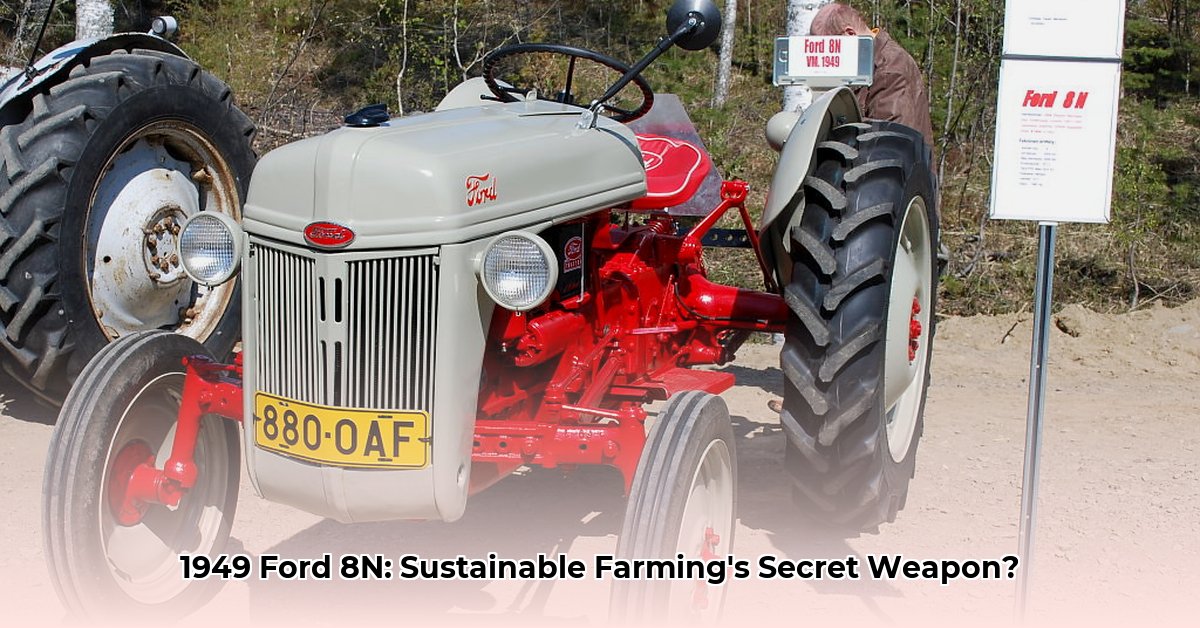
The year is 1949. Imagine a world where farming was largely a backbreaking endeavor, dependent on the strength of horses and human muscle. Then came the Ford 8N tractor, a seemingly simple machine that irrevocably altered the course of agriculture and offers surprisingly relevant lessons for sustainable farming today. This isn't just a story about a sturdy tractor; it's a narrative of ingenuity, resilience, and the enduring power of simple, well-designed solutions. For more details on this iconic machine, check out this site.
A Steel Horse That Changed Everything
Before the 8N, farming was brutally physical. Harvesting a field was a multi-day ordeal, and plowing was pure hard labor. The 8N, a relatively affordable and robust machine, promised—and delivered—a new era of efficiency. Its compact design and reliable engine provided farmers with a tireless, mechanical assistant, dramatically reducing the labor involved in numerous tasks. This wasn't merely about speed; it was a fundamental shift in farming methodology. Less downtime meant consistently higher output, boosting agricultural productivity. The 8N wasn't just an agricultural innovation; it became a catalyst for social and economic change, enabling smaller farms to compete more effectively. Didn't this significant increase in efficiency contribute to improved food security for a growing post-war population?
Built to Last: A Legacy of Longevity and Repair
One of the most remarkable aspects of the 8N is its extraordinary longevity. Many meticulously maintained examples are still in operation—a testament to its design. Unlike modern equipment often criticized for planned obsolescence, the 8N was built to last. Its parts were readily available, and repairs were relatively straightforward—a significant factor in its cost-effectiveness and environmental friendliness. This durability stands in stark contrast to the significant environmental and economic costs associated with constantly replacing equipment. Wouldn't a focus on repairability be a key element of future sustainable agriculture? It’s a powerful question that resonates deeply with environmental considerations.
The pride of ownership was palpable. Farmers cherished their 8Ns, viewing them not just as tools, but as symbols of progress, opportunity, and a more prosperous future. The tales passed down through generations paint a picture of resilience and unwavering reliability. "My grandfather swore by his 8N," recalls Sarah Miller, a third-generation farmer from Iowa. "He said it was the best investment he ever made; it paid for itself many times over."
An Unexpected Sustainability Champion
While the concept of "sustainable agriculture" wasn't prevalent in 1949, the 8N's characteristics remarkably align with modern sustainable principles. Its inherent efficiency translated to lower fuel consumption, minimizing its environmental footprint. Its lengthy lifespan minimized waste, both of raw materials and manufacturing energy. The simplicity of its design stands out in contrast to the complexity and disposability of much of today's farm machinery. The 8N's design is surprisingly relevant in today's sustainable efforts. How many modern machines boast similar longevity and repairability?
Lessons for a Sustainable Future
The 8N's story is more than a nostalgic reminiscence; it's a crucial lesson for the future. It underscores the importance of designing durable, repairable equipment. Its success wasn't purely technological; it was about creating a practical, accessible tool. This highlights the vital role of simplicity and functionality in sustainable practices. We can learn from its enduring impact and strive to design agricultural equipment with similar longevity and resilience.
Dr. Emily Carter, Professor of Agricultural Engineering at Cornell University, notes, "The 8N's design philosophy, emphasizing simplicity, durability, and repairability, offers a valuable blueprint for future farm machinery. This approach could significantly reduce waste and lessen the environmental impact of agriculture."
Key Takeaways:
- The Ford 8N's design prioritized simplicity, durability, and ease of repair, making it an exceptionally cost-effective and long-lasting machine.
- Its efficiency and longevity directly contributed to reduced fuel consumption and minimized waste, aligning with modern sustainable agriculture principles.
- The 8N’s lasting impact demonstrates the importance of prioritizing quality, simplicity, and repairability in the design of modern agricultural machinery to support sustainable practices.
The 8N's legacy is far-reaching. It serves as a potent reminder that sustainability is not solely about adopting new technologies, but also about making informed choices that prioritize efficiency, durability, and longevity. The Ford 8N tractor—a testament to a simpler era—remains a powerful symbol of sustainable practices relevant today.